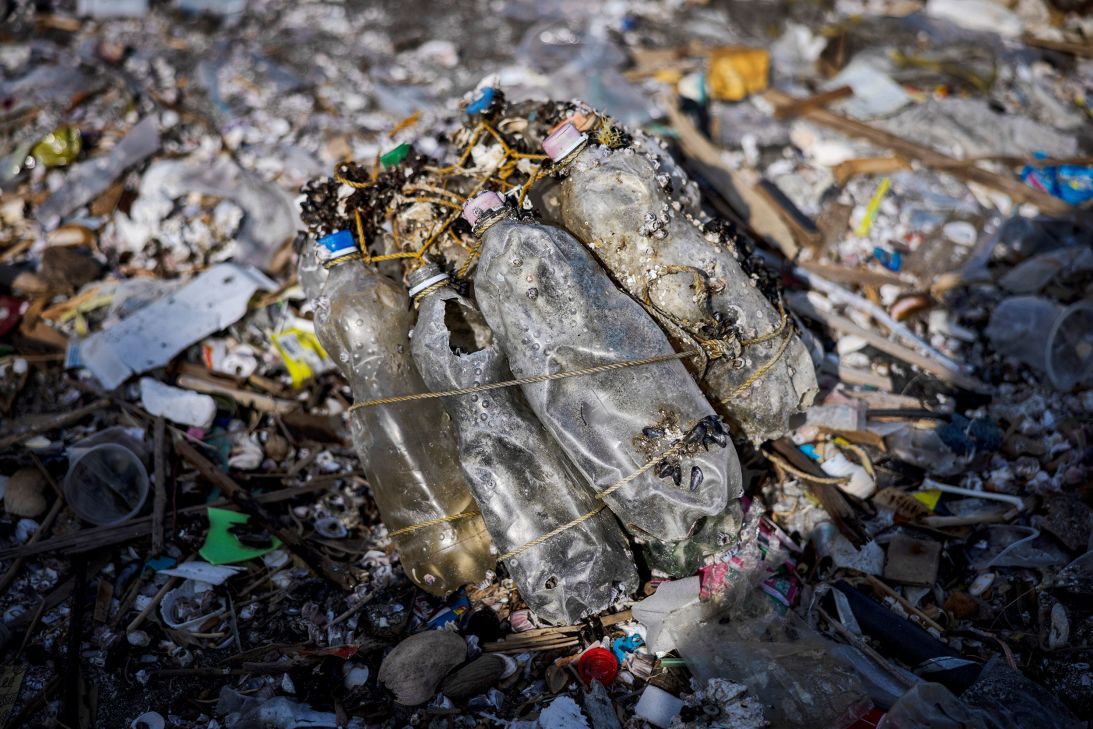The surging tide of microplastics is already an environmental and health threat, but as the world heats up — driving increasingly extreme weather — it’s transforming them into “more mobile, persistent, and hazardous pollutants,” according to a new study, which calls for urgent action.
The connection between plastic and climate change usually focuses on how plastic is partly to blame for the crisis: more than 98% of it is made using fossil fuels, and climate pollution is released during every stage of its life cycle, from manufacture to disposal.
Much less covered, however, is how climate change itself, by fueling more frequent and intense heat waves, fires and floods, increases plastic pollution, spreads it wider and even makes it more dangerous.
A team of scientists pored over hundreds of studies and found “ample evidence” that climate change is worsening plastic pollution in our water, soil, atmosphere and wildlife, according to the analysis published Thursday in the journal Frontiers in Science.
“Plastic pollution and the climate are co-crises that intensify each other,” said lead author Frank Kelly, a professor at Imperial College London’s School of Public Health.
The links are multiple and complex.
Rising temperatures, humidity and sunlight break plastic down, making it brittle and cracked, accelerating its disintegration into tiny fragments. A 10-degree Celsius (18 Fahrenheit) rise in temperature during an extreme heat wave could double the rate at which plastic degrades, the study noted.
Extreme storms, flooding and wind also hasten the breakdown of plastic, mobilize it and spread it more widely. Typhoons in Hong Kong, for example, increased the concentration of microplastics in beach sediments nearly 40-fold, according to a recent study.
In a strange twist, flooding can also help forge “plastic rocks,” created when rocks and plastics form a chemical bond and merge together. These become hotspots for microplastic generation.

Wildfires, fueled by high temperatures and drought, burn through homes, offices and vehicles, releasing microplastics and highly toxic compounds into the atmosphere.
Then there are the microplastics already in existence. Sea ice traps and concentrates microplastics when it forms, making it a store of plastic pollution but as global temperatures rise and sea ice melts, it could flip to becoming a major source.
Climate change can also make plastic more harmful, the analysis found.
Microplastics act as “Trojan horses,” carrying substances like pesticides and forever chemicals — so-called because they don’t easily break down in the environment. Higher temperatures can help plastics absorb and release these harmful contaminants more easily, as well as increasing their ability to leach harmful chemicals contained within the plastic itself.
As the twin crises of plastic pollution and climate change collide, the impacts on animals, especially marine life, could be significant, the report found.
Research on corals, sea snails, sea urchins, mussels and fish has found microplastic pollution left them less able to cope with rising ocean temperatures and ocean acidification, both fueled by climate change.
Some filter-feeding animals, like mussels, become full of microplastics and transfer these to their predators, pushing pollution up the food chain. “Apex predators such as orcas could be the canaries in the coal mine, as they may be especially vulnerable,” said co-author Guy Woodward, a professor of ecology at Imperial College London.

The study suggests multiple solutions for the crisis, including reducing plastic use, reusing and recycling, as well as redesigning products and eliminating unnecessary single use plastics.
The “greatest hope” for success would be a legally-binding global plastics treaty aimed at ending pollution, the report says. However, years of negotiations have failed to produce any agreement, as countries remain bitterly divided, especially on whether to impose limits on plastic production — something many environmental experts say is vital to curbing the crisis.
Finding solutions is increasingly urgent, the report authors argue, as the situation is set to worsen. Global annual production increased 200-fold between 1950 and 2023, and is predicted to keep increasing as the world moves toward clean energy and oil companies shift investments to plastics.
“We need to act now, as the plastic discarded today threatens future global-scale disruption to ecosystems,” said Stephanie Wright, a study author and associate professor at Imperial College London’s School of Public Health.
Tamara Galloway, a professor of eco-toxicology at the University of Exeter, who was not involved in the research, said the analysis was important, especially as it looks to the future to understand what might happen if humans continue to warm the world.
“There is definitely a lack of studies that consider both of these global health challenges together,” she told CNN. “At the base of both is a need to reduce the excessive patterns of consumption that are driving both climate change and plastic pollution.”

